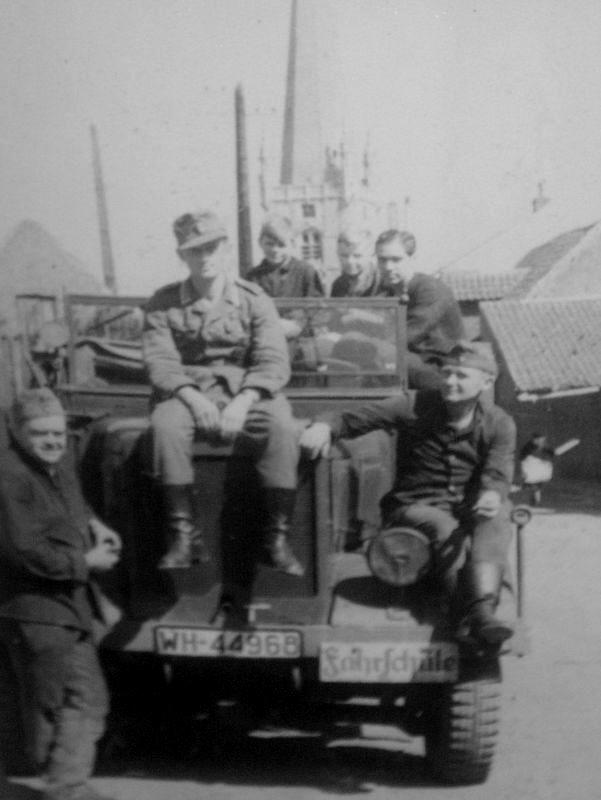
World War II Motor Vehicles: Wheeled Vehicles--Trucks

Figure 1.--This is a World War II German transport truck. There is a sergeant sitting on the hood of the vehicle for the snapshot. It looks to have been taken mid-war, probably about 1942. The church in the back ground suggests in was taken in the Reich. The license plate identifies it as a Heer vehicle belonging to Wehrkreis IV (Dresden) military district/replacement army. We do not yet know about the vehicle make and type. The snapshot has no date on the reverse, estimating around 1942 time period or earlier. Notice the plate: Fahrschule. That means driving school. Unlike American boys, many if not most German boys went into the military not knowing how to drive.
|
|
Although not often conceived as a major weapon system, the truck along with the tank, played a critical role in mobile warfare. And here was a critical weakness in the German war plan. Hitler launched world war II with a Wehrmacht that was not fully mechanized. The only military force that was fully mechanized in 1939 was the British Army. The inadequacies of German logistics did not show up iduring the short campaigns in Poland (September 1939), the West (May-June 1940), and the Balkans (April 1941), but it did manifest itself in the massive invasion of the Soviet Union fouught on a huge fronr with long supply lines (June 1941). The Wehrmacht entered the Soviet Union still highly dependent on horsepower. German manufacturers were incapable of producing the number of vehicles needed. This created massive pronlems for the Germans. It left them highly dependent on the limited Soviet rail system, restricting operations to rail heads. And to conduct the invasion in the time frame given, the Wehrmacht seized vejicles from all over occupied Europes. This mean they were using all kinds of vehicle types from many different mabufc\turers. It resulted in a maintenance nightmake because of the vast number of parts thst had to be stocked. And the German horses proved incapable of withstanding the rigors of the Russian winter. In contrast, the truck prived to be a vital part of the Allied victory. The World War I experience had taught the American Army the importance of using a small number of vehicle types and interchangeable parts. The work horse for America was the 2½ ton dual axel truck--the phenomenal duce and a half. It was built by several different manufactuers (General Motors, Mack, Studabaker, and others), but the parts were interchangeable. In all the United States built an astonushing 2.6 million trucks and they were key to the Allied victory. Not only did American trucks make possible the rapid drive liberating France, but American trucks (many of which weee Studabakers) delivered to the Soviets through Lend Lease were a key factor in the 1944 battles that demolished the Wehrmacht on the Eastern Front. Not only did the give the Red army phenomenal mobility, but the arrived loaded with spam, blankets, and other materisl. OKW was unprepared for the mobility that thge American Lend Lease trucks gave the avenging Red Army. World War II trucks came in various sizes. The iconic truck of World War II was the American duce-and-a-half. It was not only made in huge numbers and was not just used by the Americans, but supplied to America's allies as well.
CIH -- World War II

Navigate the CIH World War II Section:
[Return to Main World War II motor vehicle type page]
[Return to Main World War II motor vehicle page]
[Return to Main World War II land technology/tactics page]
[Return to Main World War II technology/tactics page]
[Return to Main World War II page]
[About Us]
[Aftermath]
[Biographies]
[Campaigns]
[Children]
[Countries]
[Deciding factors]
[Diplomacy]
[Geo-political crisis]
[Economics]
[Home front]
[Intelligence]
[Military forces]
[POWs]
[Resistance]
[Race]
[Refugees]
[Technology]
[Totalitarian powers]
[Bibliographies]
[Contributions]
[FAQs]
[Images]
[Links]
[Registration]
[Tools]
[Return to Main World War II page]
[Return to Main war essay page]
[Return to CIH Home page]
Created: 4:57 PM 12/31/2011
Last updated: 4:57 PM 12/31/2011



